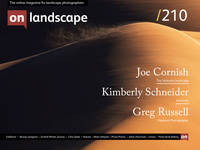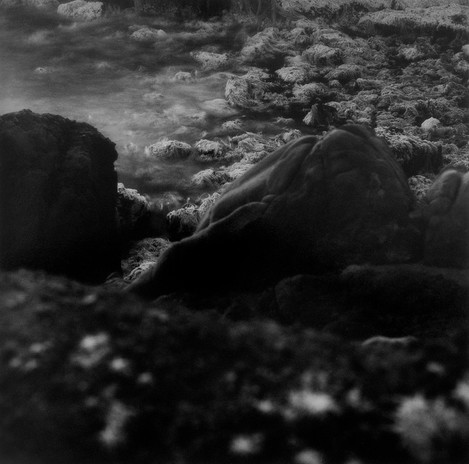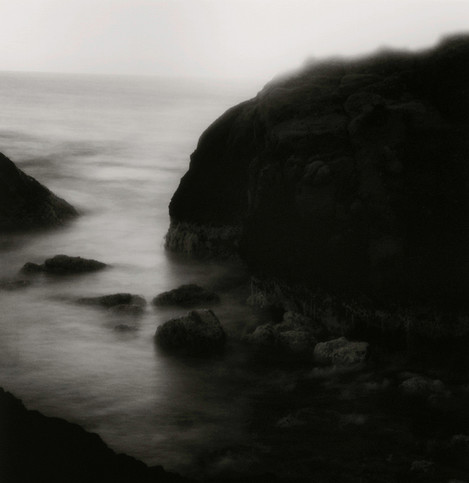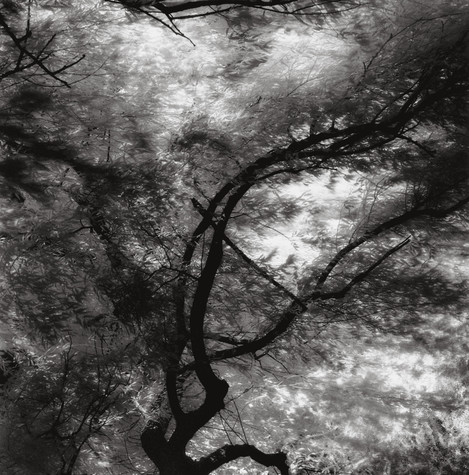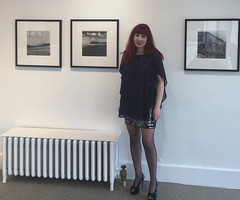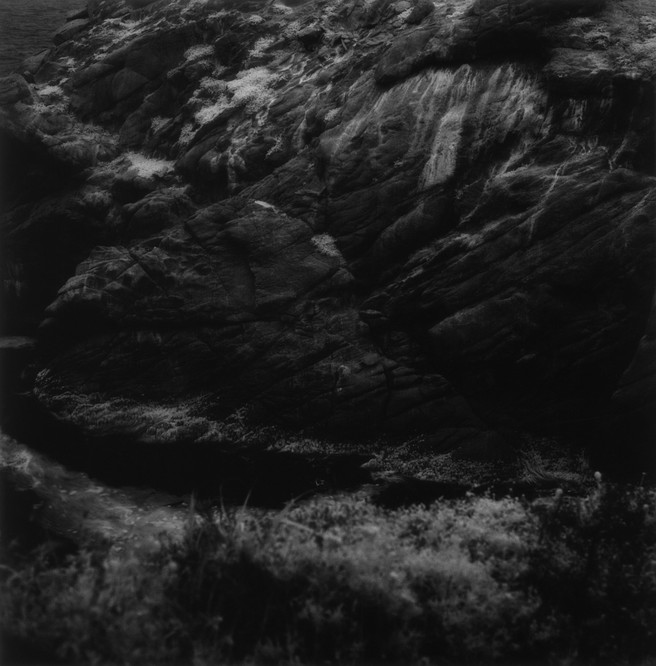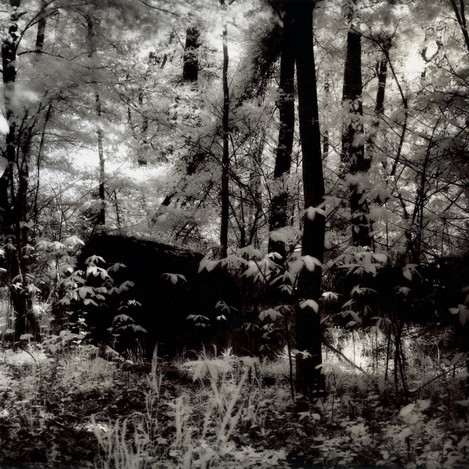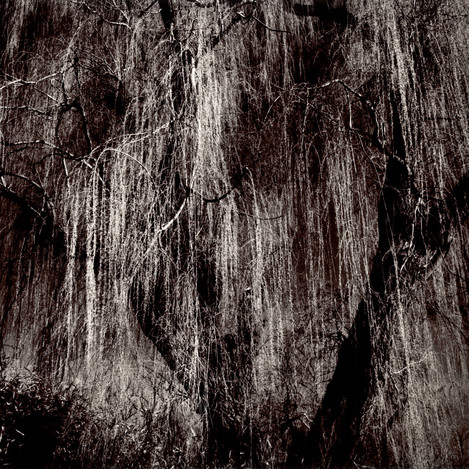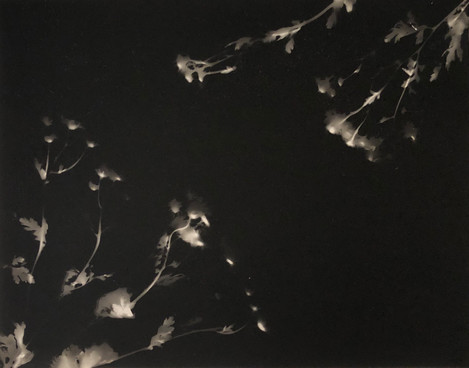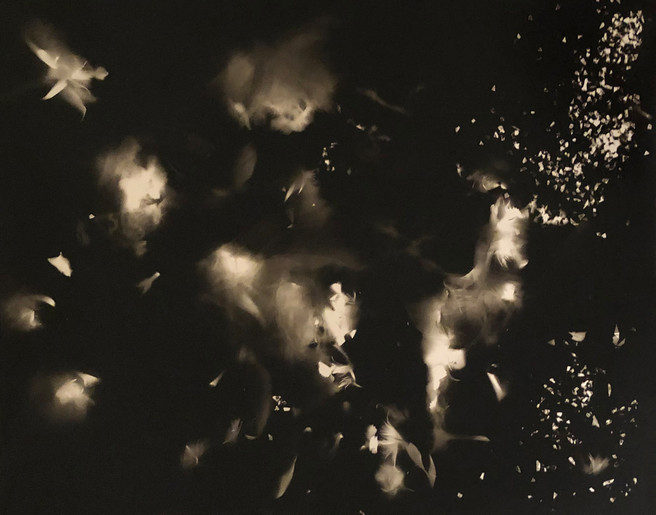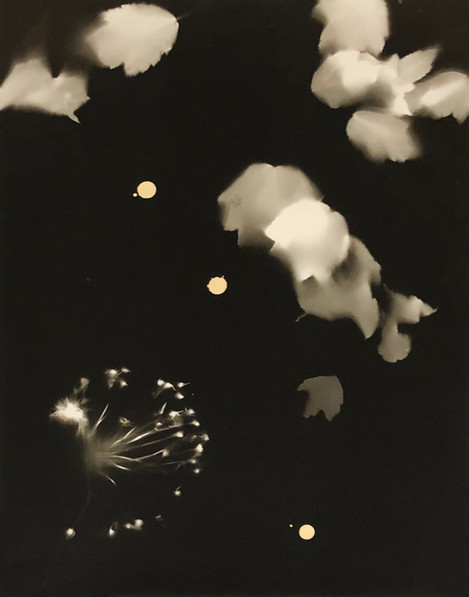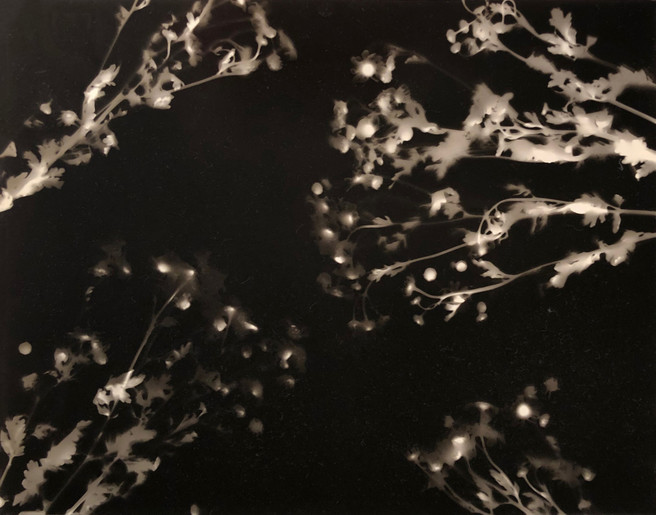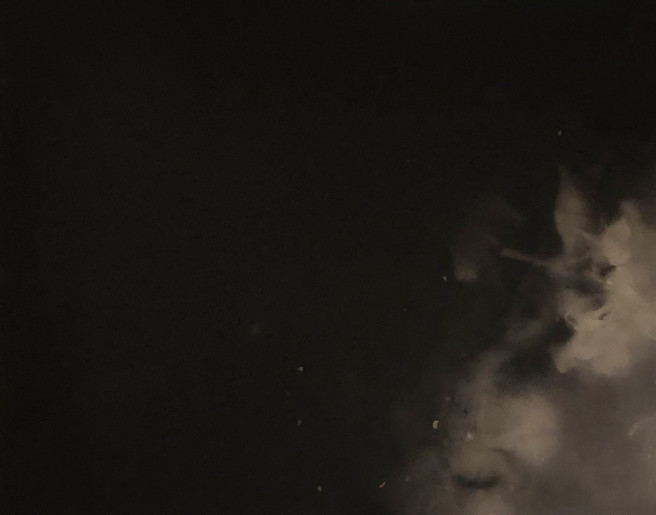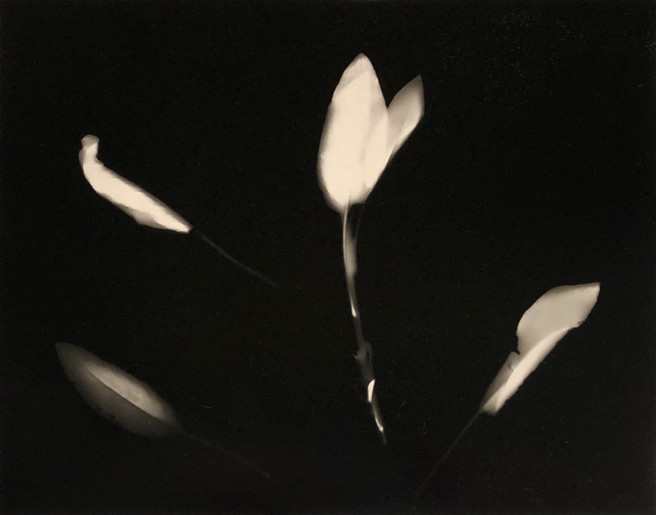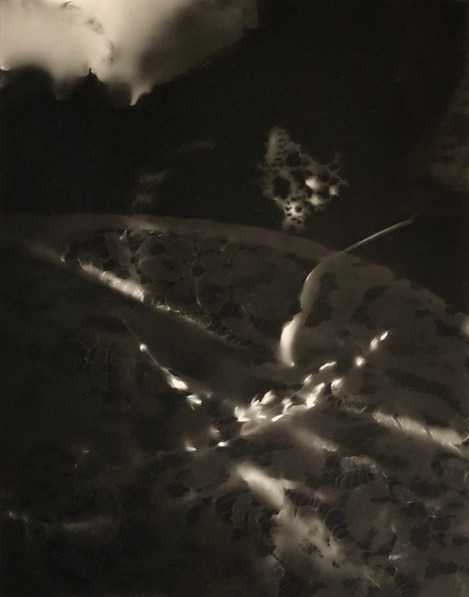Traditional Processes and Adapting to a changing world

Kimberly Schneider
Kimberly Schneider was born in Chicago, in 1977. As a teen, she was always taking photos, but it wasn't until she started working for a photographer in 1999, that she decided to make photography a career choice. She graduated from Colorado State University in 2002, with a BFA in photography (and minor in philosophy), and has been based in New York City for the past 15 years.
Kimberly lives and breathes photography, and is truly dedicated to the art of the handmade print; She not only prints all of her own work by hand, but also teaches (both privately and at Penumbra Foundation), as well as prints for others.
Schneider began making photograms due to having an unfinished darkroom at the time of the shutdown; In less than a year, she had nearly completed a trilogy of new (cameraless) work and began teaching some of her new processes (online). Her second online course is currently open for registration.
Her handmade prints have been exhibited at The Camera Obscura Gallery, San Diego Art Institute, Scott Nichols Gallery, Art Intersection, ZIA Gallery, Photo Méthode Gallery, Stonehenge Gallery, Troy University, Lightbox Photographic Gallery, among other galleries, and she continues to show her work regularly.
Kimberly’s new work recently placed 3rd in the 16th Julia Margaret Cameron Awards, as well as Honorable Mention in the 16th Pollux Awards; She looks forward to exhibiting 9 of the award-winning photograms in the upcoming 6thBiennial of Fine Art and Documentary Photography, which opens, at FotoNostrum Gallery - in Barcelona, Spain, on December 9th

Charlotte Parkin
Head of Marketing & Sub Editor for On Landscape. Dabble in digital photography, open water swimmer, cooking buff & yogi.
Back in August 2014, we interviewed Kimberly about her Awakenings - Point Lobos and Beyond project. Kimberly was inspired by Edward Weston and had dreamed of making images at Point Lobos. Since then Kimberly has been included in multiple exhibitions and publications.
When we got an email from Kimberly at the beginning of June to say she’d set up her darkroom again and started experiment with photograms. Responding to the limitations of Covid19 lockdown has been a challenge for a lot of photographers creativity, so we were interested to find out more. We wanted to find out what had happened since the last interview, particularly about her darkroom work, and how she had adapted to the lockdown.
It’s six years since we interviewed you about your Weston’s Point Lobos project. Tell us what you’ve been up to since then.
Well, I’ve pretty much been to hell and back - at least once since then, so that’s actually kind of a loaded question. I suppose I should start at the beginning…
Back in 2014 - Many Successes
When we last spoke in 2014, I was living in the same building I currently live in and had a much larger, fully functioning darkroom at home. I also had THE darkroom guy of darkroom guys. So, my set-up was a lot less complicated than the current one.
2014 began during the Winter Solstice show at Scott Nichols Gallery, which was in San Francisco back then (has since relocated to Sonoma), and Scott had personally asked me for work for the show. So, I started out the year showing at one of my favourite galleries. Soon after, I exhibited at Art Intersection for the first time, when my work was selected by Tom Persinger, for the Light Sensitive exhibition there; my work was also awarded Honorable Mention, by MIFA (Moscow International Photo Awards), selected by Fotofilmic for the 2014 ShortList, interviewed by Style No Chaser (was the featured artist when the article went live shortly afterwards), had my work featured on Your Daily Photograph, as well as selected by Aline Smithson, for the Summer Fun Exhibition via Lenscratch, and also had my work selected for other publications/platforms, including The Natural World group show, via F-Stop Magazine (Issue 64).
Within the same year, my work was also exhibited internationally for the first time, when Joseph-Philippe Bevillard invited me to exhibit 6 of my prints at his gallery, Gallery Revival, for the Photographic Arts show; the gallery was in Ireland, I’m not quite sure if they’re still around.
[This also happened to be the year I started doing freelance work with Eve Kahn, and that work eventually led to her book, Forever Seeing New Beauties - which not only sold out the day it launched in New York last year, but also featured two of my images; I’m trying to keep this fairly brief, so I’m leaving out the press and related events in between the first shoot and the book coming together.]
2015 – Further exhibitions and print sales
My work was shown internationally again, in 2015, when my image was selected for the Fifth Annual Exposure Award via See Me; “Undercurrent,” was included in the Nature book, as well as in a digital display presented at the award reception -- at the Louvre, on July 13th.
On the domestic front, my work was also selected by Robert Hirsch, for the 2015 Light Sensitive show, selected by Stephen Perloff for a special web exhibition on The Photo Review website, included in issue 9 of The HAND (the magazine sold out), featured by a couple other online publications/platforms (Float Magazine, Saatchi), and I also got picked up by Zia Gallery that year - in time to have work in the End of Year Group Exhibition; Zia was my Chicagoland gallery for several years (more about that later).
2015 was also the first year I was invited to contribute work for the FWAB (Friends Without a Border) 18th Annual Friends of Friends Photography Auction at the Metropolitan Pavilion in NYC; the print sold. Later that year, I had the honour of being asked by Steve Anchell, to contribute to the 4th edition of The Darkroom Cookbook (the original was basically every hardcore printer’s bible, ever since it first came out, in the 70’s).
2016 – Starting large format
In 2016, The 4th edition of The Darkroom Cookbook, was published; you can read about one of my darkroom tricks on page 47. My work was also exhibited quite a bit at Zia that year; I had my first solo show (technically a two-person show; I showed with Clyde Butcher) - which actually got a decent amount of press, I had work in the Third Annual Photography Now exhibition, as well as both End of Year Group Exhibition(s) (the year began with the prior year’s End of Year Exhibition.)
Outside of Zia, my work received an Rfotofolio Choice Award, for the INPrint Competition (you’ll read about the related exhibition in a bit) and was also featured in issue 15 of Musée Magazine.
I was gifted with a Crown Graphic (converted for field use) that year; for those not familiar, this is a 4x5, which was used mainly as a press camera in the 30’s and 40’s
What was amazing about receiving this camera as a gift, is that it was given to me by someone that I, at the time, only knew via Facebook; he followed my work and knew that I wanted to go large format - and out of the goodness of his heart, reached out offering one of the two 4x5’s that he wasn’t using (he’s an 8x10 guy), as both were sitting around collecting dust. I chose the Graflex and he didn’t charge a cent, only asked me to cover shipping.
[Despite owning my first 4x5, finding an appropriate lens for the type of work I do, has been challenging with that particular camera, but I stopped looking while I was between darkrooms, so this is still a work in progress - which I will be revisiting soon.] Ok, on to 2017...
2017 – The loss of my Darkroom
2017 is a particularly tough year to write about, so please bear with me.
The year began on a positive note with a feature in Underexposed Magazine, followed by having “Undercurrent” again selected – this time by Blue Mitchell, for Visual Armistice, the Plates to Pixels 10th Annual Juried Showcase, had work in issue 16 of Looking Glass Magazine, as well as in the exhibitions of both INPrint, and the 2017 Light Sensitive show; the later was juried by Ann M. Jastrab. The year ended with my exhibiting work in 2 of Zia’s group shows (Photography Now and End of Year). Things pretty much went south after that, but I was still exhibiting and having work selected or featured, even after I lost my darkroom, a little more than 3 years ago.
Before I get to the tough stuff, I will add that that I also contributed a print to the Off the Wall Exhibition and Silent Auction, at Art Intersection during my time between darkrooms; the print sold.
Ok, here goes… In late April of 2017, despite doing everything in my power to avoid it, I literally lost my darkroom, and for the next three years, printing and most of my art life had had to be put on hold. I haven’t really shared a lot of the below with too many people, and I’m sure that those who follow my work have been wondering why they haven’t seen much new work from me during that time, so figured it was time to just put it all out there.
Basically, when I lost the darkroom, I had to start from scratch to find stable work, as the darkroom was put into “temporary” storage – and would remain there until I was able to turn things around. It’s been a really long road back from what I refer to as the limbo years, but I’m already making up for lost time, so feel a little better about sharing some of this now.
A week before losing the darkroom, I was actually under the impression that my building was going to give me at least a three-month extension, before insisting upon a renewal. Two days prior to having to move, I found out, that was not the case. As a result, I literally had to watch my beloved darkroom being torn down (the makeshift walls actually had to be torn down to the framework to get the contents out), knowing I might never be able to afford to get it back and properly running once I left.
I was actually planning on moving back with family, as I simply wasn’t in a position to commit to another lease at the time. By sheer luck, I found a month-to-month sublet - just in the nick of time to avoid having to commit to moving out of state, which is the only reason I’ve been able to stick around this whole time.
Quite honestly, that was the worst place I ever lived (a railroad with a major rodent problem, that was on such a severe slant, that I would get vertigo if I stood in front of the bathroom mirror for too long) -- but it was the last-minute miracle that kept me here long enough to find stable work that wasn’t deterred by my Fine Art/printing background, which is what eventually helped me get my darkroom back, so it was worth it to suck it up (for two very long years).
Before the move, I actually checked out Gowanus Darkroom with a friend, but knew that it would be quite a while before printing again would be feasible, so tried to put it in the back of my mind, but once a printer always a printer…
Gowanus is basically the only shared space in NYC I would ever consider printing at, and I did end up printing there eventually, so they definitely deserve a shout out. Unfortunately, given their public hours and my work schedule, they weren’t really an option until I could commit to a membership, so I went almost a full year-and-a half without printing – and truthfully, the printing withdrawal nearly killed me.
I actually tried to get myself inspired to paint or get back into making jewellery (which I still do from time to time), but I just couldn’t get into either as my only way of making handmade art for that entire period of time, so was in a pretty dark place for a while. I did do some writing from time to time but was a far cry from making deep soul-cleansing art, so as far as I’m concerned, that barely counts.
2018 – back to printing
Fortunately, things started to look up a little in 2018, when Scott Nichols asked me to send him some prints for the Women of the West show (at his gallery). By then, I had managed to find work in the photography/printing/production industry, so that took some pressure off, but the printing withdrawal was driving me nuts, and I was already getting sick of exhibiting images that had become pretty recognizable, so really wanted to print some new images for the exhibition – which is why I reluctantly decided to give public hours (at Gowanus) a try.
Oh, I learned my lesson fast! Worst experience printing with a newbie ever. I’ll leave it at that; I became a member the next day. I still had to pull all-nighters on weekends to have enough consecutive hours to print but am truly grateful that they exist!
After that, I went as often as possible, but I could never really spend much time there between work and the commute - and being as there was only one cold head enlarger at the time (I'm not a condenser girl) didn’t help matters. So I was mainly dabbling/testing out images or pulling the occasional all-nighter on weekends, but never got on a good print flow during my time there. (Still, just printing a little bit, really made all the difference the world.)
I did take part in Gowanus Open Studios that year, as well as Zia’s Photography Now show, but that would be my last show with the gallery. We parted ways later that year. I didn’t blame them, I wasn’t making much new work and barely promoting, so I did plan on working on representation in my hometown again, once I could find my way back to consistent printing.
2019 – finding a darkroom friendly apartment
Less than a year later, the woman who owned the sublet decided to jack up the rent (and refused to fix anything the entire time I lived there), so between that and paying for storage all along, the month-to-month wasn’t really worth the hassle anymore. That’s when I decided to start plotting my escape and immediately began looking for darkroom friendly apartments (that would at least be affordable once I was back to taking on printing work in my downtime).
The only reasonable option was actually in the very same building where my last darkroom was - and I knew I wasn’t going to find any more affordable options, so when I signed the lease, I was actually preparing to return home. And that was the first time I started to see a semblance of my old life coming back.
On April 28th of last year, I moved out of the sublet, and at long last, my darkroom came out of storage and moved home; it almost feels like fate to be back here. Who knows? Maybe it is…
Yet, getting the darkroom set up properly was no easy feat, since my amazing darkroom guy had moved too far away to be able to set me up himself, as initially planned. Over a year later, and it’s still not completely done. I couldn’t in my wildest nightmares have predicted so many delays…
I was still using Gowanus here and there while hunting for a new darkroom guy, but it eventually got to be too much of a commute to keep it up until I knew a definite eta my darkroom would be properly finished, so I ended up cancelling my membership 5 or 6 months ago.
It literally took seven months, just to find one plumber who was willing to work on a private darkroom and had any availability whatsoever (I miss you John DeLuca!!!). The one plumber willing to take on the job, only did so, because he found it interesting and wanted to help, so he was basically a Hail Mary.
My darkroom was his first, so there was quite a learning curve for him, but I did have some printing friends and my former darkroom guy advising him remotely as questions I couldn’t answer myself came up, which helped tremendously. The delays on the plumbing were simply due to him being in high demand for much higher-paying jobs, which is why he’s been helping me in stages. I was actually having come by before work and letting him work on the darkroom after I left because he’s a trustworthy guy and has such limited availability (would’ve taken months longer if I only had his work when I was actually home).
At any rate, his part of the darkroom was essentially done before the shutdown; I had expected the rest of the darkroom to be fully operational no later than late March, worst case, but the only people I could find willing to help are a couple of friends from work, who don’t have a ton of downtime, so they weren’t able to come back before the shutdown.
New Experimental work
Therefore, the new experimental work was my first chance to really print the way I need to, in order to make the kind of art I want to put out in the world -- since 2017!!
This type of printing is also the only way I know how to make work, that will eventually grow into a series (and meet my very high standards) – and I’m a stickler for cohesive bodies of work, so anything less than that, just doesn’t cut it for me, which is why I haven’t shared much of what I made when I was printing at Gowanus.
So, now you see why I’ve been pretty much sucked into the darkroom over the past few weeks… I don’t really do individual images anyway, that’s just not how I work. Of course, I make exceptions if there’s a special request for an image and sometimes I do opt to print something special for a last-minute deadline, but it’s not the kind of printing that I can really get into unless am printing for another artist or client (my printing process is dramatically different when it comes to printing commercial work).
I just want to quickly add that as far as 2019 shows, I wasn’t really submitting to much while the darkroom was in pieces on the floor, so I may be missing a feature or two, but I don’t remember showing at all last year. I currently have work in this year’s Light Sensitive show, and as you know, have just started my very first cameraless series – made by hand, but exposed via alternate light sources (not the enlarger) – in motion. Some with multiple exposures. This is actually the only really experimental work I’ve ever made, and it’s a really crazy process, but am super inspired and can’t wait until I have a chance to get back to printing, later this week.
Tell us about this new experimental work which began at during the COVID19 Lockdown? What were the driving factors behind it?
Actually, it didn’t begin until after I’d been in isolation awhile.
The Start of Making Photograms
I began to experiment with photograms due to the fact that my darkroom was not finished before the shutdown. Basically, after so much time in isolation, I couldn’t keep staring at the darkroom anymore, so the experimental work happened because I was determined to figure out a way to make some type of art, before it would be safe for anyone to resume work on the darkroom.
To be perfectly honest, I happen to be one of those people who really needs structure; without it, I sort of turn into an insomniac vampire - and having been in isolation, in an apartment that doesn’t get much natural light, since March 20th has pretty much magnified that. The inability to be around other humans was also killing me (I'm a super social person when not sucked into the darkroom) so, the experiments (and Zoom meetings) are sadly the only things resembling structure in my life these days.
Plus, printing has always been kind of a physical need for me, and as I mentioned earlier, I’ve spent the bulk of the past 3 years in printing withdrawal, so my intention all along was to just find a way to make “serious” artwork, and get some stress out at the same time - while I had the downtime. I wasn’t sure if I’d be able to make anything that met my standards but was pleasantly surprised.
Basically, by April, it was clear that the stay at home order was going to stick for awhile, so I started trying to figure out how I could rig my apartment and make space to deal with light leaks I couldn’t get to by myself in the darkroom. Unfortunately, the unfinished stuff took up a LOT of space in the darkroom and I also was expecting someone to hang a ton of framed artwork I don’t exactly have space for, so it literally took almost two months to prep the place for what I’ve was initially referring to as “the coronavirus version of printing.”
When I first began making these photograms, my goal was to make some type of cameraless art that would be abstract - and as naturally expressive and spiritual as my typical work, as well as somewhat painterly. I had hoped it would at least feel like my true IR work in some way but had no idea where to begin or if that was even possible with my darkroom in its current state.
As a classically trained printer, who has never really had the time to experiment or funding for workshops, it did take some time to let go of control, but I don’t really know how to do things halfway, so once I got into it, I essentially changed as an artist – overnight.
The First Experiments
I began my very first experiments on June 9th – and to be honest, was actually shocked that my alternate light source idea was producing successful results from the get-go. I began with flowers and a flashlight, then moved on to a firework LED, and threw in some other materials - but it wasn’t until I decided to pump out a few more experimental prints in advance of my most recent portfolio review (as in last Thursday), that inspiration really hit.
I ended up pumping out more than 20 new experiments that night - and that’s when I started taking what began as a motion study of light, to a whole new level; I could already feel the work leading to a series before that, but it wasn’t until I did some really rigorous editing/sequencing, that the series was truly born.
It is too early on to know where the work will lead, but anyone familiar with my traditional work knows that my photographs are about much more than the beauty that inspires me to release the shutter - so cameraless or not, these images, are still in the same realm as my traditional work. We’ll just have to wait and see where they take me.
That said, my work has always been about unpeeling the layers, and looking beneath the surface of things, for what might not be obvious at first glance - and that does seem to translate to my cameraless work, so I expect some of that to continue to come through in the series.
**Please note that all of the current photos of the prints are cell shots taken in less than ideal lighting; the pandemic has not exactly made it easy to have work scanned or shot somewhere with better lighting/more space. (I am planning on taking better photos of the prints in the near future.)
Photograms have a rather special place in the history of photography, were you inspired by any of the early photogram work?
That’s actually a really good question. While I’ve been a huge fan of Man Ray’s Rayographs for over 20 years, when I started making these photograms, I was just messing around, seeing if I could get anything interesting without fogging the paper. I really didn’t think I was going to get into making cameraless work other than maybe cyanotype or some other type of experimental contact prints.
When the early experiments worked, I started to take things further but this work, and thus, the series has been completely unexpected. It’s literally just coming out of me before I have time to really think too much about it, so it’s more intuitive, than anything else (particularly, when I’m testing out a new light source or material or working with light sources I have minimal control over).
You say on your website ‘printing has always been kind of a physical need for me, so going so long without printing or being around humans really threw me off for a while.’ Why do you think printing is a fundamental part of who you are?
It’s a spiritual thing. I fell into art/photography while studying upper-division eastern religions and they (mainly Taoism and Buddhism) found their way into my work, as well as my process - and never left. Printing is really how I process things. I suppose you could think of it as art therapy, but to put it more simply, the darkroom is really just the only place I can totally let go and chill. So I basically had 3 years of printing withdrawal stress when the shutdown began, it’s just now starting to dissipate…
Further, I have always been so strongly connected to my work, that I can’t separate myself from it, so when I’m not printing (or at least exposing film) consistently, it’s kind of like a part of me dies. That might sound a bit extreme but should at least clarify a bit more.
How did you go about exploring the photograms that you’ve produced? There must have been some failure pieces along the way. How did you structure this learning and go about refining your techniques?
My process for making art is a lot less contrived than that. I’d say it’s as Taoist of a process as shooting has always been for me. Making these experiments, at least for the most part, has been about playing and just having fun and seeing what works and not overthinking anything.
Fortunately, I had ton of old paper when I started, so I just tried something, if it worked, I would find the next material or three that caught my attention and try them out with the same alternate light source, sometimes changing the settings, other times, doing double or triple exposures. Really just playing. There’s been a real freedom about making this work.
To elaborate, I’m making unique gelatin silver (fiber) prints, with various alternate light sources - that are actually moving or flashing in some way, as I expose; timing is by feel half the time, so my printing process is basically the opposite of how I’ve always worked in the past. [But in case there was any doubt, I haven’t let go of control when it comes to development and toning, etc.]
Of course, I not only have high standards, but am learning as I go, so there have been certain prints that turned into accidental lumens, others that had to be edited out as the series grew, or just weren’t that interesting, and other light sources turned out to be one hit wonders. Sometimes, I had to make a few tests, just to get a feel - for how long to expose by feel!
This is a brand new, very strange way of working for me, and I have to admit, that I’m enjoying the process much more than I expected to (and I’m really psyched to get back in the darkroom with some new light sources and materials - which should be arriving this week!).
Yes, there are times, when I can’t quite let go of control as much as I’d like to - for example, an image that has an area that’s totally blown out or underexposed; I might hate it at first, see it a few days later, turn it sideways, and suddenly that blown out or underexposed area actually makes the image stronger. Sometimes it’s hard to wrap my head around, but usually if I give it a day or two, I feel differently. Or else, I just start doing more experiments…
Honestly, so far, the only real challenge with these experiments has been being able to maintain that freedom by not getting too in my head about the images from a technical standpoint.
You have one of your newer “Awakenings” images in the ‘Light Sensitive Exhibition’ at Art Intersection how did this opportunity come about.
As noted earlier, this is actually an annual juried show; the Jurors change, but the premise is the same. This will actually be my 4th time exhibiting work in the Light Sensitive show. As an analog printer, this one of my favourite shows to exhibit at; is also nice to be showing with so many friends and contemporaries whose work I admire.
“Untitled, Point Lobos” was shot on true infrared film in 2012, but I didn’t make a final print of it until 2016, so is still on the newer side of my Awakenings/Lobos work. (It’s been a while since my last trip to California, is long overdue…)
Do you see yourself going back to more traditional film photography now that the lockdown has eased or do you see your photography evolving in a different way?
Well, the lockdown hasn’t quite eased up over here yet (NYC), but at least is getting to the point where darkroom help can happen and by the time it’s done, I think potential printing/workshop/Fine Art clients will feel more comfortable coming over, so that’s at least encouraging. (We’re in phase 3, but not fully. Places are just starting to open in some areas, but it’s more in pockets than throughout the city, so I’m still in isolation as I write this.) The silver lining is that all this is really making me grow as an artist - and it’s an ongoing process.
As of now, I see myself alternating between traditional silver work and experimental. I’m really inspired to continue on with the cameraless work but missing my enlarger terribly - and have at least 3 bodies of film-based work that have been on hold for way too long (and are dying to come out once am able to travel again).
I have also been mulling over different alternative processes, so wouldn’t rule out including a small edition of alternative process film-based work [the dream is infrared platinum/palladium, which I was actually in the process of starting to learn before the shutdown, but we hadn’t gotten to the printing part yet; my digital negative is still waiting for me in Staten Island, so when it’s safe to return, so my very first attempt at platinum will be platinum IR. Unfortunately, the cost of palladium is insane right now, so probably not the process I’ll use for the next film series.]
While I do already have loose plans in mind for the next film-based series, each series I create is a direct progression from the prior - and I don’t think going cameraless is going to change that, so only time will tell just how much the current work will impact the next body of work. (Honestly, it will likely be a subconscious thing that reveals itself during my printing process, so that’s about as much detail as I can give this early on.)
Regardless, I think it will be somewhat of a departure from my typical traditional work, but I do plan on letting my classically trained printer brain out by then, so is hard to predict.
- Untitled, Point Lobos
- Undercurrent
- Memory #2
- Abstract Rock
- Wonderland Part 2
- Willow #3
- Reaching Out
- Unknown Presence #2
- Untitled, Light Dripping
- From the Ashes
- Dark Side of the Moon
- Flower
- Untitled (firework)
Who has specifically helped you in realizing your photographic ambitions over the past few of years?
Well clearly, a lot of my photographic ambitions were on hold most of that time, so since I’ve really only been back to consistent printing since June, this mainly applies to those who have really helped me get back to being the artist I’ve always been, despite the unfinished darkroom and the hiatus from making “serious” work.
The one exception is one I don’t usually like to advertise, but to be perfectly honest if it weren’t for my family taking a risk on the fact that I plan on returning to printing work as soon as my darkroom is finished, I wouldn’t even living in New York right now, much less printing from home. There are no words that could possibly convey how grateful I am for that type of support.
[The delays have obviously made things much more challenging, so I’m very happy to tell you that a tentative date for resuming darkroom work has now been scheduled.]
I also have to give a huge thank you to a few photo friends who got me out of my classically trained printer’s brain and kept me inspired to figure out a way to make new work during the shutdown.
Morgan Post, who is not just an amazing artist, but who has actually become one of my closest friends, particularly since the shutdown. Let’s just say he’s gotten me out of my classically trained printer’s brain more times than I can count and been incredibly supportive of the new work all along. Any time I get too in my head about this strange new way of making artwork, he’s pretty much the first person I call. (He’s also just an awesome human being in general.)
Ross Sonnenberg is usually the second person I reach out to. Haven’t know him as long or as well but have been a huge fan of his work since before we met in person and he’s been super supportive of the new work as well (he’s the one who inspired me to start playing around with sparkler exposures. I actually called him before the first test to make sure I wasn’t going to start a fire.) He too, is someone I tend to bounce things off of if I get too in my head about this new way of working.
And she’s probably going to be embarrassed by the shout out, but Laura Bennett (a fellow photo nerd/darkroom geek – who I have yet to meet in person) was actually the first person who really got me thinking about doing experimental or at least cameraless work, long before I got the idea to start making experimental photograms.
She literally sent me a care package full of stuff from her own darkroom at the beginning of the shutdown, so I could try to figure out a way to make art before the darkroom was done. This was at least a month before rigging the darkroom even seemed feasible, so that really helped a lot. (Photo karma is a beautiful thing…) When I make my first cyanotype (soon), you’ll be able to thank her for that.
I also did a couple portfolio reviews recently but am not sure how the reviewers would feel about a public shout out, so I’ll just say that both of them have already given me a lot of great feedback about the new work at times when I really needed it.
Honestly, I’m not one to get nervous when showing my traditional silver prints (well ok unless I spotted them myself; I rarely do that, as is the one part of the process I really struggle with) – but with the experimental stuff, I have had my moments of doubt and both reviewers really got me past things I was stuck on or hadn’t quite gotten far enough along into the series to understand just yet; I don’t think the series would have started to come together so fast if not for them, so Zoom or not, I was really fortunate to get my work in front of them so early on. And still am - to have their continued support.
[Of course, there are many other photo friends and contacts who have helped along the way, but if I shouted out everyone who has been there at some point within the past 3 years, this interview would probably end up being 30 pages - maybe more, this is already getting pretty long…]
Light Sensitive Exhibition at Art Intersection
I was honoured to have my work selected by Brett Abbott, Director of Collections and Exhibitions at the Amon Carter Museum of American Art in Fort Worth, for inclusion in this show, which celebrates the art of the handmade print. Art Intersection presents Light Sensitive, tenth-annual, international juried exhibition of images created using traditional darkroom, historical, and alternative photographic processes and methods.
Address: 207 N Gilbert Rd # 201, Gilbert, AZ, 85234

